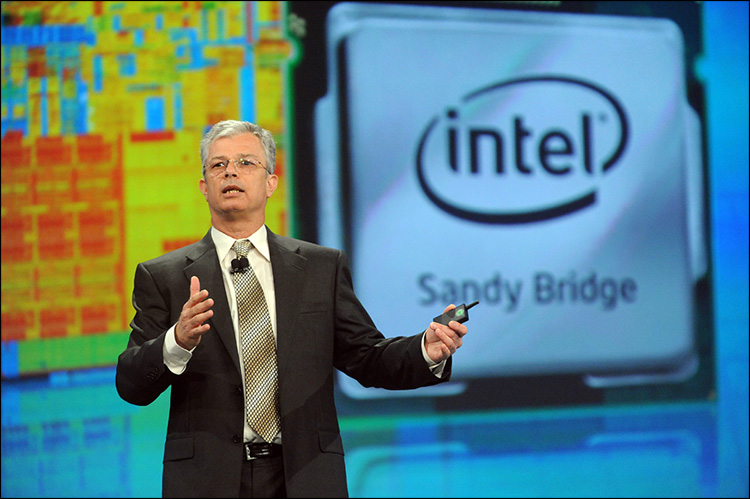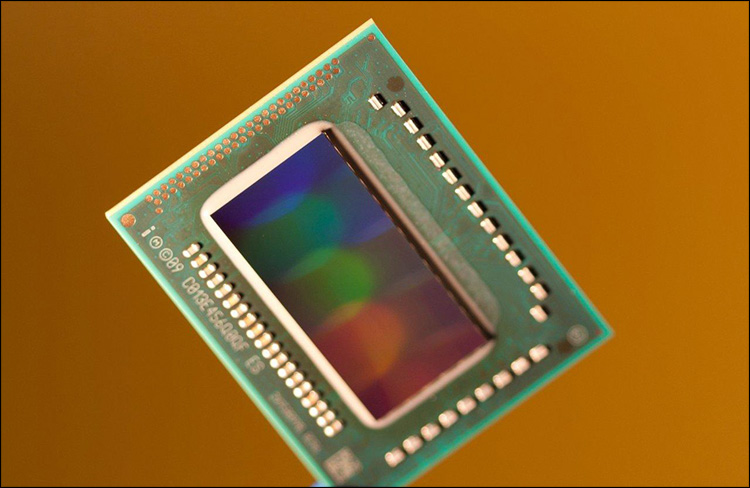Intel Developer Forum: Sandy Bridge and new graphics
At IDF in autumn in autumn, Intel introduced a new micro-architecture of processors, codenamed Sandy Bridge, for desktops, laptops and next-generation Xeon servers. The first laptops and desktops with new generation Intel Core processors will be available in early 2011.

David Perlmutter, general manager of the Intel architecture group, is demonstrating a new Sandy Bridge architecture.
Key differences Sandy Bridge:

Mobile chip Sandy Bridge.
')
As we already mentioned, the graphics adapter integrated into Sandy Bridge works much faster than the previous generation integrated graphics. In 2007, at IDF, Intel promised a ten-fold increase in the performance of integrated graphics by 2010 - now the head of Intel, Paul Otellini, says that this prediction was surpassed: the graphics integrated in Sandy Bridge show a 25-fold increase.

This is due not only to the placement of the graphics core on the same silicon substrate with the central processor, but also the improved architecture of the processor itself. Tom Piazza , an expert on graphics architectures and Intel Fellow, says that his team has taken a new approach to organizing the architecture of new graphics adapters, in particular, to the programmability of graphics pipelines. The Piazza team uses a small number of graphics pipelines, focusing on optimizing the pipelines themselves - for example, new instructions that allow for several operations per clock. “ It ’s not so important how many pipelines we use — more importantly, how many FLOPS we get at the output, ” Piazza shares.

Screenshot from Wolfenstein: Ray Traced. Note the reflections in the candelabrum.
These are not all the achievements of Intel in terms of graphics presented at the Intel Developer Forum. In the same place on IDF, Daniel Paul and Bill Mark demonstrated a prototype of the Wolfenstein: Ray Traced game , which uses real-time ray tracing. It is implemented on the Knight's Ferry cluster, which transfers the image to the player’s laptop — in the future, similarly, it will be possible to organize cloud computing services that perform complex gaming calculations on a supercomputer graphics cluster and then transmit the image to the consumer’s mobile device.
About this and other technologies - in the following reports with the IDF.
Successes!

David Perlmutter, general manager of the Intel architecture group, is demonstrating a new Sandy Bridge architecture.
Key differences Sandy Bridge:
- Fully 32-nanometer process. In the processors of the Nehalem microarchitecture, produced by the 32-nm process, the graphics core was produced using the 45-nm technology and packaged in a single package. In Sandy Bridge, the graphics processor is placed on the same silicon substrate with a central processor.
- Thanks to the placement of the central and graphics processor on the same silicon substrate, Intel Turbo Boost technology has been improved compared to the previous generation of processors - now the cores of the central processor and graphic resources can simultaneously change their performance depending on the task.
- A new set of 256-bit instructions Intel Advanced Vector Extensions (AVX), which allows to increase the performance of the floating point - in other words, with multimedia applications such as sound recording or video processing.

Mobile chip Sandy Bridge.
')
As we already mentioned, the graphics adapter integrated into Sandy Bridge works much faster than the previous generation integrated graphics. In 2007, at IDF, Intel promised a ten-fold increase in the performance of integrated graphics by 2010 - now the head of Intel, Paul Otellini, says that this prediction was surpassed: the graphics integrated in Sandy Bridge show a 25-fold increase.

This is due not only to the placement of the graphics core on the same silicon substrate with the central processor, but also the improved architecture of the processor itself. Tom Piazza , an expert on graphics architectures and Intel Fellow, says that his team has taken a new approach to organizing the architecture of new graphics adapters, in particular, to the programmability of graphics pipelines. The Piazza team uses a small number of graphics pipelines, focusing on optimizing the pipelines themselves - for example, new instructions that allow for several operations per clock. “ It ’s not so important how many pipelines we use — more importantly, how many FLOPS we get at the output, ” Piazza shares.

Screenshot from Wolfenstein: Ray Traced. Note the reflections in the candelabrum.
These are not all the achievements of Intel in terms of graphics presented at the Intel Developer Forum. In the same place on IDF, Daniel Paul and Bill Mark demonstrated a prototype of the Wolfenstein: Ray Traced game , which uses real-time ray tracing. It is implemented on the Knight's Ferry cluster, which transfers the image to the player’s laptop — in the future, similarly, it will be possible to organize cloud computing services that perform complex gaming calculations on a supercomputer graphics cluster and then transmit the image to the consumer’s mobile device.
About this and other technologies - in the following reports with the IDF.
Successes!
Source: https://habr.com/ru/post/104184/
All Articles